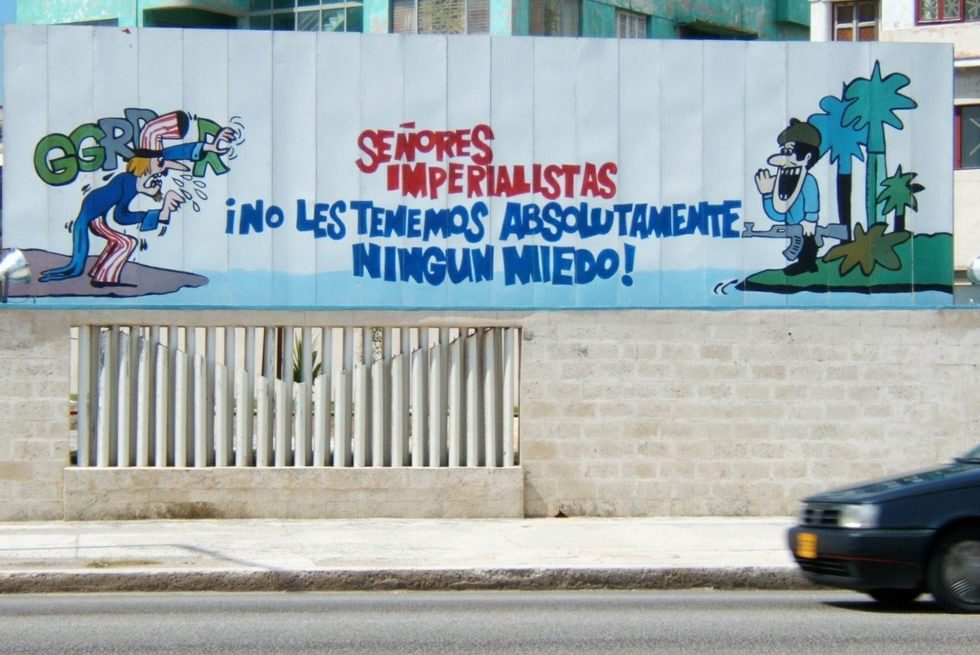On Beans, Rabbits, and Cows: Food for Thought on New Cuba–U.S. Relations
From the Series: Cuba as Dreamworld and Catastrophe
From the Series: Cuba as Dreamworld and Catastrophe

A 2014 cartoon published at the Daily Signal with the title “Barack and the Beanstalk” shows a naïve President Obama excitedly telling a compatriot, “Look! I traded for magic beans . . . from Havana!” As a sneaky Fidel Castro runs for the border, a freshly traded cow in hand, Obama’s compatriot offers a correction: “Uhh . . . Mr. President . . . Those are rabbit pellets.” Intended as a critical commentary on Obama’s negotiations to end the embargo against Cuba, the cartoon invites further reflection on who stands to win or lose with the future normalization of agricultural trade between Cuba and the United States.
The headline of an Associated Press article acknowledges that “U.S. agriculture has big appetite for Cuba trade,” since the industry would be one of the biggest beneficiaries of such an exchange. Cuba, for its part, has much to gain from being able to import food and agricultural inputs without costly restrictions. Yet, based on past experience, there is reason to be wary. As Cuban celebrity chef Nitza Villapol (1988) has pointed out, trade with the United States has not always been beneficial for the Caribbean nation. Prior to 1959, when Cubans were starved for animal protein, the U.S. hog industry sold excess lard of little nutritional value to Cuba, leaving them stuck with indigestible waste.
This combination of unfair trade practices and state neglect supposedly changed once the revolutionary government made food security and good nutrition national priorities. By 1982, even a U.S.-commissioned report conceded that the Communist government of the small Caribbean nation had eliminated almost all malnutrition. It was difficult to imagine then that less than a decade later, Cuba would be facing one of the worst food crises in revolutionary history.
Many of Cuba’s favorable trade agreements with Soviet-bloc countries came to a halt in the late 1980s. The nation suddenly lost two-thirds of its food supply, as well as crucial agricultural inputs. Fidel’s brother, Raúl, exhorted the revolutionary army to turn to food production, exclaiming: “Today, beans are more valuable than guns!” Beans, standing in for food more generally, would not only ensure the literal survival of the population but also the survival of the revolutionary government. To produce food with near zero inputs, Cuban agriculture now had to be local, small scale, low-input, and sustainable.
While international observers enthusiastically applauded these changes as the greening of the revolution (Rosset and Benjamin 1994), average citizens on the island experienced them as symptoms of extreme food scarcity. In the capital city of Havana, driven by la necesidad (need), people turned to tending vegetable gardens in vacant city lots and raising farm animals in home patios, rooftops, and even bathtubs.
To be successful, small-scale city farmers in particular had to master what a Cuban friend playfully called the art of flying without wings (volar sin alas). This was about more than just learning to make do with meager resources; it was about knowing how to turn disadvantages into opportunities to do things differently. In my research, this was best illustrated by Manolo, a Havana resident in his late forties who wanted to raise rabbits on his home rooftop but could not afford the price of rabbit pellets. Applying his knowledge of mechanics, Manolo made a dehydrator of recycled materials that allowed him to turn kitchen leftovers and refuse from a nearby agricultural market into a nutritious, homemade rabbit feed. He went even further, creating a closed production system that included chickens, guinea pigs, potted greens, and animal excrement. Manolo and many other urban farmers expressed pride at their ability to turn so-called waste into food or additional money for their households. They waxed lyrical about the high quality of home-grown products that, in their opinion, far surpassed the products of an earlier state-managed, highly industrialized agriculture system (see Premat 2012).
For some within Cuba, the sustainable agriculture born out of the crisis, much like the magic beans in “Jack and the Beanstalk,” represents future wealth that could be easily destroyed by greed or short-sightedness. For them, knowing that U.S. food giants like Cargill have lobbied to end the embargo so they can “offer high-quality, affordable, safe food to Cuban citizens” is a red flag. Cargill, after all, is not only a key supplier of the fast-food industry in the United States but has been involved in several tainted beef scandals over the years. Against this backdrop, it is easy to recall the earlier Cuban indigestion described by Villapol and to look less favorably upon the U.S. cow depicted in the Daily Signal as the coveted loot of a shrewd Fidel.
The shrewdness of the Cuban government at the negotiating table will indeed be crucial in ensuring not only that Cubans get more food options, but also that these options are worth having in the long term. It remains to be seen if food sovereignty and sustainable agriculture will remain high priorities for Raúl Castro or if giant agrifood corporations will be allowed to flood the Cuban market, as in the past. In the meantime, there seems to be enough reason to hold our applause on the promises of agricultural trade.
Premat, Adriana. 2012. Sowing Change: The Making of Havana’s Urban Agriculture. Nashville, Tenn.: Vanderbilt University Press.
Rosset, Peter, and Medea Benjamin, eds. 1994. The Greening of the Revolution: Cuba’s Experiment with Organic Agriculture. Melbourne: Ocean Press.
Villapol, Nitza. 1988. Cocina al minuto. Santiago de Cuba: Editorial Oriente.